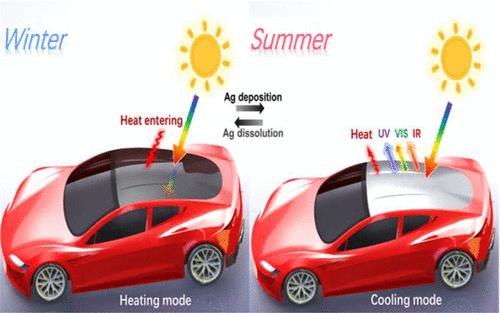The Flexible Electronic Reflection Smart Windows for Automobiles and Architecture
IF 8.2
2区 材料科学
Q1 MATERIALS SCIENCE, MULTIDISCIPLINARY
引用次数: 0
Abstract
We introduce an in situ polymerization route of electrolytes for reversible metal electrodeposition (RME) devices for the first time. This method addresses the issue that initial high-viscosity gel electrolytes are difficult to use in large-area flexible devices, advancing the practical application of flexible electronic reflection devices (F-ERD). The in situ polymerized quasi-solid-state electrolytes significantly enhanced the mechanical properties and safety of devices. Our F-ERD exhibits an average transmition modulation range of 81.6% in the visible spectrum and an average reflectivity of 88.3% in its reflective state, with only a 9.3% reduction in visible-light modulation range after 1000 bending cycles. Notably, we have successfully fabricated the largest flexible RME device (171 cm2) to date. This study also pioneers the use of flexible RME-based smart windows in automotive panoramic sunroof designs. Energy consumption simulations reveal that F-ERD offers substantial energy-saving potential across various seasons and regional conditions. Furthermore, outdoor temperature experiments demonstrate superior temperature management capabilities, with rooms equipped with F-ERD being 12.4 °C cooler than those with conventional glass windows. This research lays a foundation for applying RME technology on flexible surfaces, promising significant impacts on energy-efficient vehicles and environmentally friendly buildings.

汽车与建筑柔性电子反射智能窗
首次提出了可逆金属电沉积(RME)器件电解液的原位聚合方法。该方法解决了初始高粘度凝胶电解质难以用于大面积柔性器件的问题,促进了柔性电子反射器件(F-ERD)的实际应用。原位聚合准固态电解质显著提高了器件的力学性能和安全性。我们的F-ERD在可见光谱中的平均透射调制范围为81.6%,在反射状态下的平均反射率为88.3%,在1000次弯曲循环后,可见光调制范围仅降低9.3%。值得注意的是,我们已经成功制造了迄今为止最大的柔性RME器件(171 cm2)。这项研究还开创了在汽车全景天窗设计中使用灵活的基于rme的智能窗户的先河。能源消耗模拟表明,F-ERD在不同季节和区域条件下都具有巨大的节能潜力。此外,室外温度实验显示了优越的温度管理能力,配备F-ERD的房间比配备常规玻璃窗的房间低12.4°C。本研究为RME技术在柔性表面的应用奠定了基础,有望对节能汽车和环保建筑产生重大影响。
本文章由计算机程序翻译,如有差异,请以英文原文为准。
求助全文
约1分钟内获得全文
求助全文
来源期刊

ACS Applied Materials & Interfaces
工程技术-材料科学:综合
CiteScore
16.00
自引率
6.30%
发文量
4978
审稿时长
1.8 months
期刊介绍:
ACS Applied Materials & Interfaces is a leading interdisciplinary journal that brings together chemists, engineers, physicists, and biologists to explore the development and utilization of newly-discovered materials and interfacial processes for specific applications. Our journal has experienced remarkable growth since its establishment in 2009, both in terms of the number of articles published and the impact of the research showcased. We are proud to foster a truly global community, with the majority of published articles originating from outside the United States, reflecting the rapid growth of applied research worldwide.
 求助内容:
求助内容: 应助结果提醒方式:
应助结果提醒方式:


